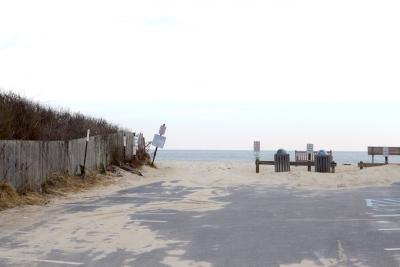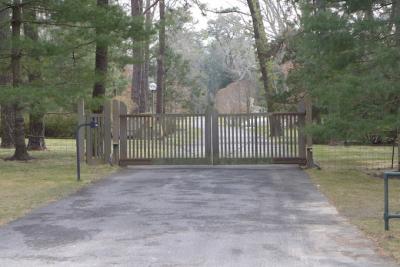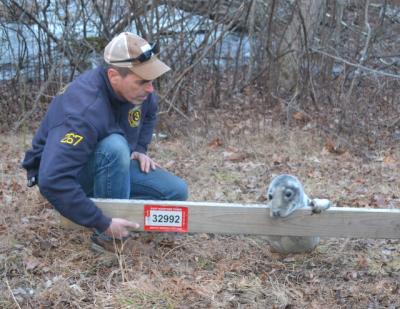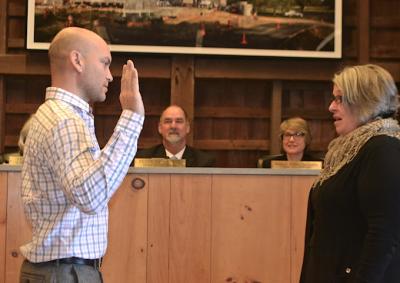Deepwater Pushes Town for Cable Easements
Deepwater Pushes Town for Cable Easements

Deepwater Wind, the Rhode Island company that plans to construct the South Fork Wind Farm approximately 36 miles east of Montauk, has asked East Hampton Town for easements allowing it to land the offshore installation’s transmission cable at Beach Lane in Wainscott.
During a presentation before the town board on Tuesday, officials from the company, which built and operates the five-turbine Block Island Wind Farm, presented the most extensive survey data to date with respect to that offshore installation. It will deliver those data, and to-date analyses of the area of its proposed South Fork Wind Farm, to the East Hampton Town Trustees’ harbor management committee tomorrow at 6 p.m. at Town Hall.
Tuesday’s presentation was “a precursor to work that will all become public,” Clint Plummer, Deepwater Wind’s vice president of development, told the board. The company plans to submit applications to multiple federal and state permitting agencies by the end of March in order to meet a timeline to begin operations by the end of 2022. The process requires the company to demonstrate that it has obtained easements over municipally owned land, which the landing at Beach Lane, and the cable’s path to the Buell Lane, East Hampton, substation would necessitate. “We can’t submit applications if we’re going to use town-owned land unless we have consent from this board,” he said.
Councilman Jeffrey Bragman questioned the premise of Mr. Plummer’s statement. “It seems to me, in my experience in environmental review, there’s usually a formal process in which your data is presented and analyzed by the reviewing entity,” he said. “I’m hoping that this kind of presentation is not what the project sponsors consider to be an environmental review that would be sufficient for the Town of East Hampton.”
There will be multiple levels of review, Mr. Plummer said, and the town will participate in all of them, but “We need the town’s consent to begin that process. . . . What we’re asking for is a conditioned decision” granting rights conditioned upon receipt of all the other required approvals.
“We have alternatives,” Mr. Plummer said, referring to state-owned land in Hither Hills, by which Deepwater Wind could bypass town board and trustee approval. “Our preference is to work closely with the town, and have conditioned approval so we can start a process using a town-owned location.”
That, Mr. Bragman said, “sounds a little like a slight arm-twist, saying you can’t work with the town” if the board opts to conduct an environmental quality review. “Intermittent presentations,” he said, are not “a cohesive way to evaluate the science you’re talking about.”
But “we’re not reviewing the entire project or its impacts,” Supervisor Peter Van Scoyoc told Mr. Bragman. “We’re talking about a landing site and easements over land to Buell Lane. So any review we would undertake would be specifically looking at potential impacts within those areas. Beyond that, all that review still has to take place as part of the myriad other permits and process.”
Mr. Bragman was unmoved. “I’m not that crazy about handing off review to a federal agency that starts that review knowing they have our consent to land that cable when we haven’t looked at the issues,” he said. If town approval is required, an environmental analysis should precede the town’s consent, he said.
Deepwater Wind seeks “a real estate right, not a permit, conditioned upon receipt of all the other approvals,” Mr. Plummer repeated, “subject to additional state and federal approval.”
“I think we support the concept,” Mr. Bragman answered, but “I want to make sure the town doesn’t wave you through without taking a good look at it. This kind of presentation makes me a little uneasy,” if it is to serve as the basis of the board’s decision, he said.
The exchange followed summaries of Deepwater Wind’s pre and post-construction surveys of the Block Island Wind Farm. “We learned a lot” from that project, said Aileen Kenny of Deepwater Wind, the majority of which is transferable to the South Fork Wind Farm. “Stakeholder engagement, early and often,” was one lesson, she said, and pointed to the Jan. 10 forum the company held in Montauk.
The most important takeaway from studies of the Block Island Wind Farm “is how much science has been done there,” said Drew Carey, a consulting scientist for Deepwater Wind, calling a six-year survey spanning pre to post-construction unprecedented.
Regular data collection demonstrates no difference, in terms of marine life or habitat, between the area where the Block Island Wind Farm’s five turbines are situated and nearby survey areas, Mr. Carey said.
An examination of the condition and stomach contents of fish including winter flounder, summer flounder, silver hake, red hake, spotted hake, and Atlantic cod show no impact from construction or operation, he said, nor was prey availability affected. A lobster trap survey designed in conjunction with commercial fishermen is also showing no adverse impact, he said.
Mr. Carey told the board that the electromagnetic field emanating from the South Fork Wind Farm’s transmission cable would not pose a danger to human or marine life. Modeling, he said, does not take into account that the cable will be buried.
A study addressing the topic will be submitted to the town in the coming weeks, Mr. Plummer said. But, he emphasized, “This isn’t new. Submarine cables have been landed on Long Island for a long time.” Existing cables carry much higher voltage, “all without impact to humans and fish, for at minimum a decade,” he said.
A particular focus, Ms. Kenny said, is the critically endangered North Atlantic right whale, which suffered “a difficult year” in 2017 with multiple mortalities in the North Atlantic. “We commit to volunteer time restrictions on pile driving,” she said. “Not that pile driving would physically harm” the animals, but it could cause a mother and calf to go farther offshore, making them more vulnerable to predation.
“Protected species observers” will call for construction to be halted if marine mammals are sited within a certain distance of the South Fork Wind Farm site, she said. The company works with groups including the National Wildlife Foundation, the Natural Resources Defense Council, the Conservation Law Foundation, the New England Aquarium, and the Mystic Aquarium “to come up with ways we can take extra measures” to protect marine mammals, she said. Avian and bat surveys indicate that the Block Island Wind Farm has not proven hazardous to winged species, she added.
Most commercial fishermen on the South Fork remain opposed to the project, and the East Hampton Town Trustees will continue to demand that Deepwater Wind demonstrate that their concerns about disruption or destruction of their livelihood are unfounded.
Fishermen have been invited to attend tomorrow’s meeting of the harbor management committee at Town Hall, said Rick Drew, a deputy clerk of the trustees and member of the committee. “The trustees have supported and protected East Hampton’s fishing interests for 350 years,” he said this week, “and we will continue to protect and support fishing interests, both commercial and recreational . . . going forward into a new era of offshore wind energy.”






